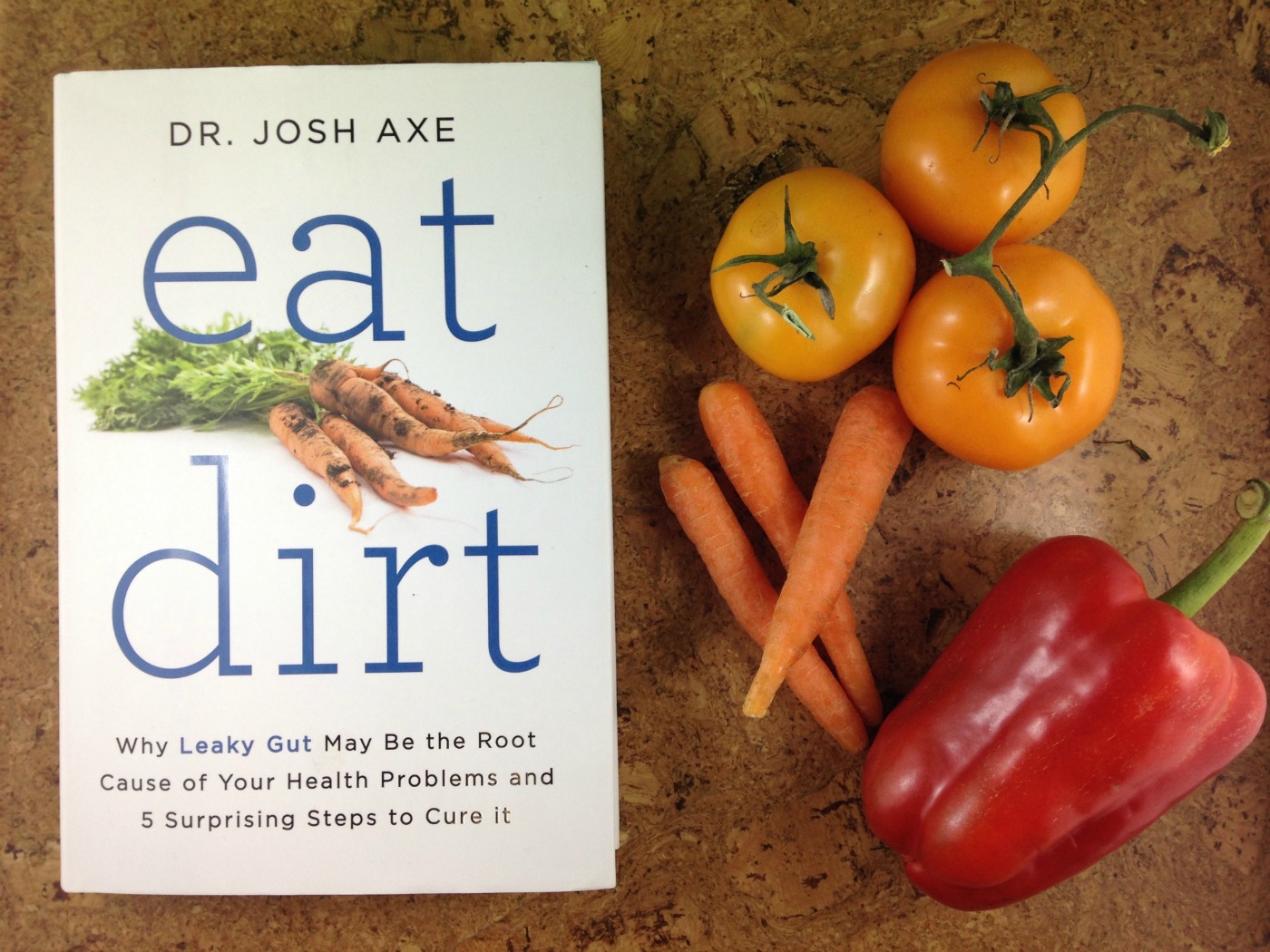New books on nutrition and diet have steadily been hitting the bookshelves at Chapters and Amazon for months trying to cash in on your “need” for information or checking out the newest “how to” diet book. You live in a culture of information overload and media skewed delivery of the latest information. Basically, you are being pulled in all directions and you’re confused as to what are the “right” choices for losing weight, rebalancing your hormones or what to eat to be healthy.
I get it. I’ve fallen prey to these same ploys. Fortunately, I love to read and glean new information. Then I take that information and decide if it is useful to my health, usually after doing more research to check out resources. One day soon, I want to offer an online nutrition/health book club, but until then I’ll stick to book reviews on my blog.
I just finished reading Dr Josh Axe’s Eat Dirt. Honestly, the title caught my attention, as well as, I’m familiar with Dr Axe’s popular blog. This read is practical and doable for anyone wanting to make some subtle changes to his/her dietary choices to improve his/her health profile.
Axe simplifies the “Eat Dirt” program to 5Rs:
- Remove
- Reseed
- Restore
- Release
- Reseal
Axe explores the root of digestive issues and unbalanced microbiome (gut flora) as leaky gut. Yes, I know you’ve been hearing about leaky gut on every social media platform. Research supports the premise that leaky gut or its more science-y term, intestinal permeability, contribute to many modern diseases and ailments. Much of that research connecting leaky gut, gluten and autoimmunity is one of the leading gluten sensitivity researchers in the world, Dr. Alessio Fasano. [2] Axe suggests that there are five factors that have lead to declining gut health: type of foods consumed, excessive sanitization, convenience, stress, and medication. Since I suffer from ongoing (yet healing) gut issues, I am very familiar with many of these factors and their influence on my health. Convenience and stress are my biggest contributors.
Eat Dirt also explores healing the whole body, especially when lingering symptoms like holding onto excess weight, overwhelming fatigue or continued digestive distress. Part Three of this book tackles healing based on your gut type. Dr. Axe explains that “When specific body systems are not functioning optimally, the path may require a slightly different approach to healing.” [3] Through studying Traditional Chinese Medicine (TCM), Axe formulated five gut types. Each gut type is explained and protocol outlined.
After taking the quiz on pages 186-187, I confirmed what I had already discovered late in 2016 — I suffer from poor digestion which has resulted in a lack of nutrient absorption, chronic antacid use (years ago now, but yes), slow motility, and SIBO (small intestinal bacterial overgrowth). According to Axe, “gastric gut is related to the fire and earth elements in Chinese medicine.” [4] Fire is related to the heart, small intestines (SIBO), and nervous system (think stress). Further, Axe says it “associated with summer, and has fear and joy as emotions.” [5] Those closest to me would tell you that I love warmth and summer. And I harbour fear and joy simultaneously. The earth element is linked to stomach, spleen, and pancreas. Interestingly, earth likes sweet foods — that’s so me! It “is associated with late summer, and has pensiveness as an emotion.” [6] These two elements describe my digestive ailments quite succinctly and a few of my likes and emotions to boot.
After flipping to the chapter titled “Healing Gastric Gut,” I first perused the summary at the start of the chapter. I immediately noticed that many of my current food choices, health practices and supplements were listed here. Under causes of the gastric gut, the suggested causes are “under chewing, overeating, and a slow digestive system.” [7] I would add impaired migrating motor complex (MMC) to that list, because it is one of the root causes of the secondary symptom of SIBO. Then I would suggest the use of prokinetics like Iberogast and MotilPro as over-the-counter (OTC) supplements to improve and heal the MMC dysfunction.
Armed with this information, I am going to implement Dr Axe’s action plan and four-step strategy for healing the gastric gut. One of the most useful sections within this chapter is the “Gastric Gut Nourishing Foods List.” [8] Many of the listed foods are the very foods I’ve identified as “good for Brenda” foods as a result of food intolerance testing and elimination diets. So here’s to my next science experiment on my body — goal digestive healing!
Are you suffering from chronic stomach or digestive issues? No one likes suffering from such ailments. They eventually become debilitating and disrupt your quality of life. From my own journey, I know that finding the root cause is important, because without it, you’ll have lingering symptoms that continue to disrupt your wellbeing and vitality.
I became a nutrition practitioner because I want to help people feel vibrant and vital well into their retirement and beyond. If you want to discuss your situation, call Brenda at 403.801.5698 or email to schedule your free Discovery Chat. I look forward to offering you results-oriented solutions.
Resources
[1] Josh Axe, DNM, DC, CNS, Eat Dirt, (New York, NY: Harper Wave, 2016) 161.
[2] Alessio Fasano, “Leaky Gut and Autoimmune Diseases,” Clin Rev Allergy Immunol. 2012 Feb;42(1):71-8. doi: 10.1007/s12016-011-8291-x. https://www.ncbi.nlm.nih.gov/pubmed/22109896
[3] Axe, 179.
[4] Axe, 183.
[5] Axe, 183.
[6] Axe, 183.
[7] Axe, 221.
[8] Axe, 230-231.
